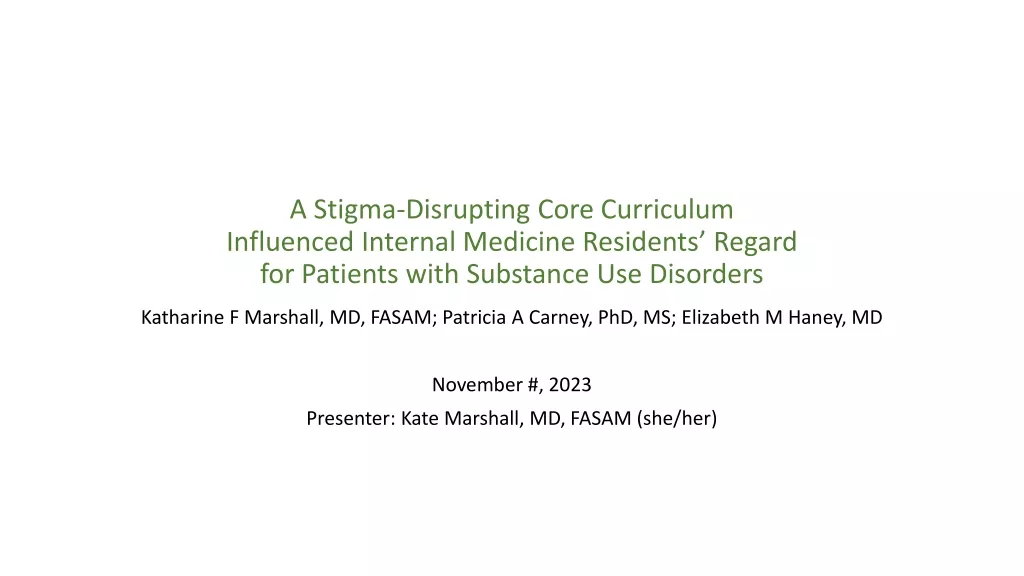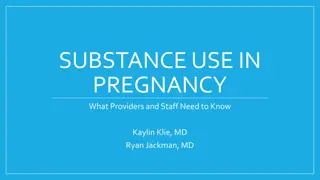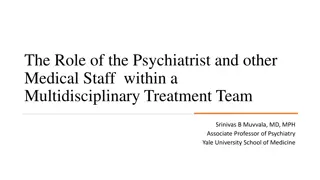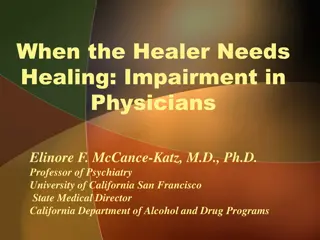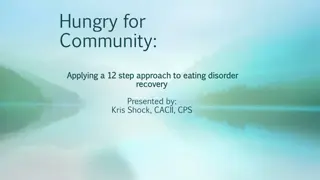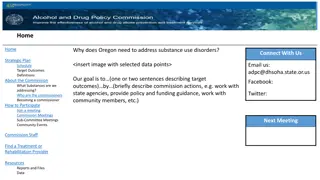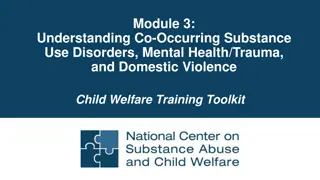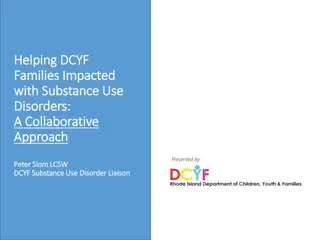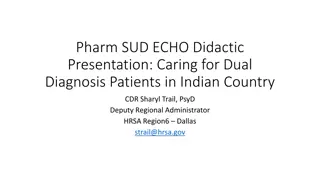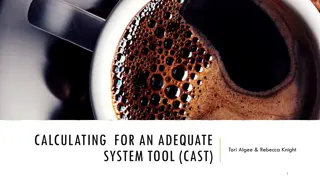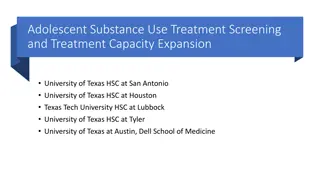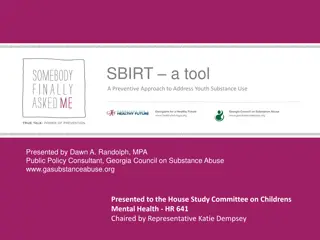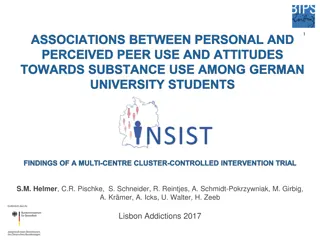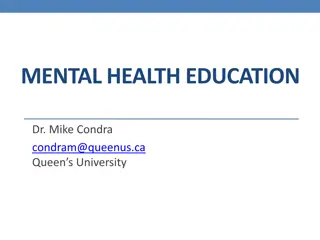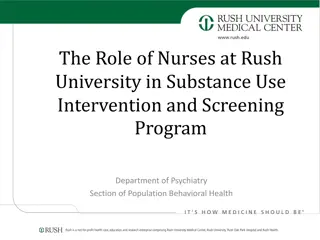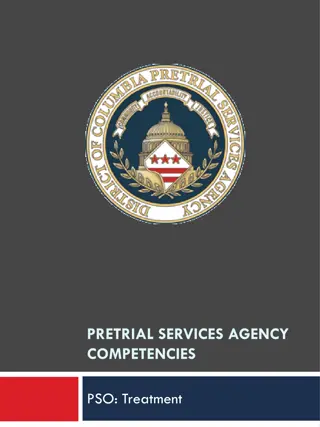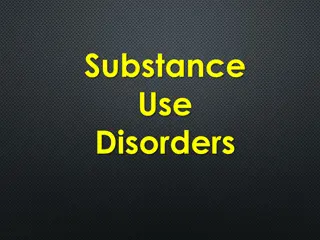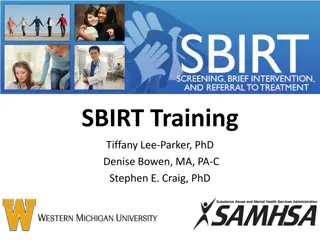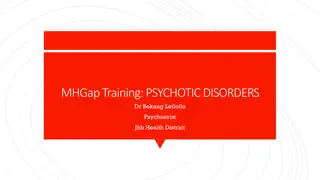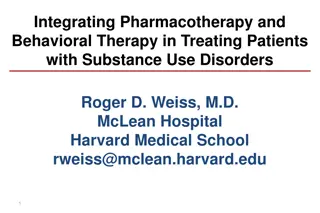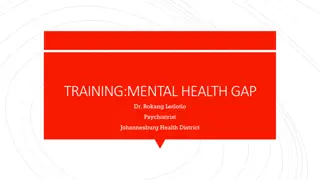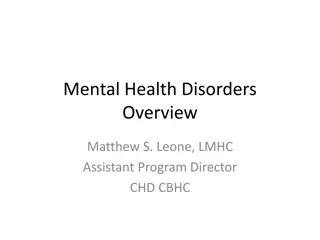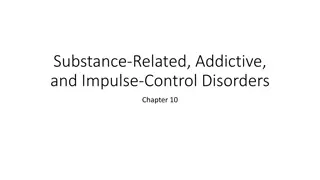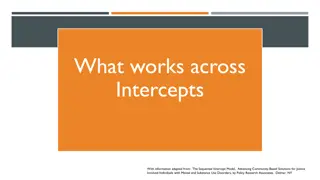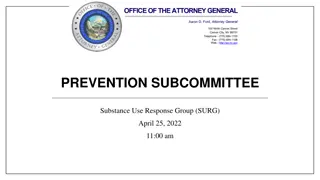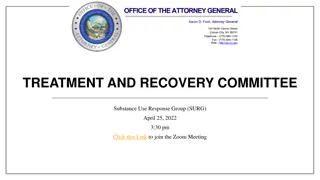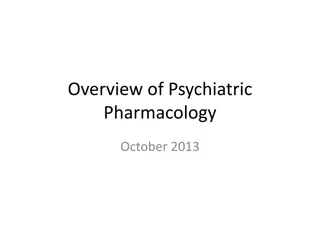Drug-Free Workplace Training Overview
This drug-free workplace training provides essential knowledge for supervisors in identifying and responding to substance misuse among employees. It covers statistics on substance use disorders, the benefits of a drug-free workplace, relevant federal laws, warning signs of substance misuse, and the
2 views • 27 slides
Enhancing Internal Medicine Residents' Approach to Patients with Substance Use Disorders
This study focuses on developing and implementing a stigma-disrupting curriculum to improve internal medicine residents' attitudes and knowledge regarding patients with substance use disorders. By addressing provider stigma and enhancing preparedness, the aim is to promote positive regard and increa
1 views • 27 slides
Substance Use Screening Tools in Pregnancy: SURP-P
The Substance Use Risk Profile Pregnancy (SURP-P) is a screening tool to assess substance use during pregnancy. It involves questions about marijuana smoking, alcohol consumption, and perceived need to cut down on substance use. Scoring determines low, moderate, or high risk levels. A brief assessme
4 views • 6 slides
Substance Use in Pregnancy: Important Considerations for Healthcare Providers
This presentation discusses the impact of substance use during pregnancy, including identifying signs of substance use disorder, trends in national and Colorado statistics, effects on maternal health and fetal development, screening recommendations, minimizing stigma, and treatment options for pregn
0 views • 35 slides
Overview of Human Genetic Disorders
Human genetic disorders encompass a range of conditions, from recessive disorders like cystic fibrosis to dominant disorders such as Huntington's disease. Examples include cystic fibrosis, Huntington's disease, and sickle-cell anemia. Understanding genetic disorders involves research and awareness o
0 views • 10 slides
SBIRT+: Tailoring Substance Use Intervention for Older Adults
SBIRT+ is a targeted training approach focusing on Screening, Brief Intervention, and Referral to Treatment to meet the unique needs of older adults, addressing risky substance use in the elderly population. It aims to address the growing concern of alcohol use and medication misuse in Baby Boomers
0 views • 38 slides
Overview of Anxiety and Related Disorders
Anxiety disorders, such as PTSD, panic disorders, phobias, agoraphobia, and OCD, are characterized by varying degrees of fear and distress. Anxiety is a normal response to danger, but when it becomes chronic, it can lead to debilitating conditions. PTSD occurs post-trauma, panic disorders involve in
1 views • 42 slides
Understanding Somatic Symptom Disorders, Conversion Disorders, and Dissociative Disorders
Somatic symptom disorders manifest as physical symptoms without apparent cause, while conversion disorders involve specific physical symptoms incompatible with medical conditions. Illness anxiety disorder involves interpreting normal sensations as disease symptoms. Dissociative disorders lead to a s
1 views • 41 slides
Understanding Co-occurring Mental and Physical Health Conditions
Co-occurring mental and physical health disorders are prevalent and require an integrative multidisciplinary approach for effective assessment and treatment. This holistic approach helps address the complexity of managing multiple disorders in an integrated healthcare setting. Through a multi-direct
1 views • 37 slides
The Role of Psychiatrists in Co-occurring Disorders Treatment
Psychiatrists play a crucial role in treating co-occurring substance use disorders alongside other medical staff in a multidisciplinary team. Integrating mental health and addiction treatment is essential, as only a small percentage of individuals with addiction receive care. Factors promoting optim
0 views • 23 slides
Understanding Functional GI Disorders: A Comprehensive Overview
Functional GI disorders encompass a range of conditions affecting the gastrointestinal system, such as irritable bowel syndrome and disorders of the gut-brain interaction. These disorders are characterized by no structural abnormalities but are influenced by factors like motility disturbance, viscer
0 views • 42 slides
The Link Between Teen Bullying and Substance Use: Insights and Implications
The article discusses the link between teen bullying and substance use, emphasizing the various forms of bullying such as physical, verbal, and cyberbullying. It also explores the relationship between being bullied and engaging in alcohol and marijuana use, highlighting statistics on how bullying ca
0 views • 15 slides
Understanding Physician Impairment Due to Substance Use Disorders
Physician impairment due to substance use disorders can severely impact patient safety and clinical outcomes. This article explores the definition, causes, warning signs, assessment, treatment, and return to practice protocols for impaired physicians. Substance abuse in physicians can lead to behavi
0 views • 50 slides
Uniting Eating Disorder and Substance Abuse Communities in Recovery
This presentation explores the intersection of eating disorders and substance abuse disorders, highlighting the similarities and differences in personality types. It delves into the high co-occurrence rates of these disorders, providing evidence for incorporating a 12-step approach to aid in recover
0 views • 19 slides
Oregon Commission Addressing Substance Use Disorders
Oregon Commission is working towards addressing substance use disorders through a strategic plan involving collaboration with agencies to create a unified system for all Oregonians. The Commission aims to achieve specific target outcomes by taking various actions, engaging with state agencies, provi
0 views • 11 slides
Understanding Co-Occurring Disorders in Child Welfare Training
This module delves into the complexities of co-occurring substance use disorders, mental health/trauma issues, and domestic violence within the child welfare system. It covers identifying various mental health disorders, recognizing signs of co-occurring disorders, understanding the impact of trauma
0 views • 59 slides
Collaborative Approach to Supporting Families Impacted by Substance Use Disorders
Peter Slom, DCYF Substance Use Disorder Liaison, presents a collaborative approach to helping families impacted by substance use disorders. Partnering with Parents Support Network, the program offers assistance, referrals, and support through Certified Peer Recovery Specialists. These specialists he
0 views • 13 slides
Substance Use Screening, Risk Assessment, and Disorder Diagnosis Guidelines for Adults
This clinical guideline program aims to increase identification of unhealthy substance use among New York State residents and improve access to evidence-based interventions. It provides guidance on substance use screening, risk assessment, and promoting a harm reduction approach for substance use di
0 views • 19 slides
Understanding Dual Diagnosis: Link Between Substance Use Disorders and Mental Illness
Dual diagnosis, also known as co-occurring disorders, refers to the simultaneous presence of substance use disorders and mental illness in individuals. This presentation delves into the definitions, treatment options, and ways to support communities to prevent overdose. Factors contributing to the c
0 views • 15 slides
Understanding CAST: A Tool for Assessing Community Susceptibility to Substance Use Disorders
CAST (Calculating for an Adequate System Tool) is a tool developed by researchers at SAMHSA to assess the protective capacity of a community and its susceptibility to Substance Use Disorders (SUD). It considers various community determinants such as demographics, social factors, and access to resour
0 views • 12 slides
Adolescent Substance Use Treatment and Screening Programs in Texas
Expansion of adolescent substance use treatment and screening programs across different University of Texas Health Science Centers in Texas, focusing on implementing systematic screening, evidence-based interventions, and referral pathways for youth with substance use disorders. The initiative aims
0 views • 10 slides
Preventive Approach to Addressing Youth Substance Use: SBIRT Tool Presentation
The presentation by Dawn A. Randolph highlights the importance of preventive approaches in addressing youth substance use. It emphasizes the need for early identification and intervention to ensure a better future for children and teenagers in Georgia. Substance abuse disorders affect millions of in
0 views • 21 slides
Understanding Sleep Disorders: Classification and Diagnosis
Sleep disorders encompass various conditions affecting sleep patterns and quality. They are classified into categories such as insomnia, sleep-related breathing disorders, central disorders of hypersomnolence, circadian rhythm sleep-wake disorders, parasomnias, and sleep-related movement disorders.
0 views • 32 slides
Associations Between Substance Use and Peer Influence Among German University Students
This study explores the associations between personal substance use, perceived peer use, and attitudes towards substance use among German university students. It focuses on social norms interventions and the adaptation of personal behavior based on perceived peer behavior. The study aims to assess s
0 views • 26 slides
Understanding Mental Health Education and Support
Explore the importance of mental health education through activities like reviewing case scenarios, card sorting, and understanding the mental health continuum. Learn about common mental health problems and their signs, including mood disorders, anxiety disorders, disordered eating, suicidal ideatio
0 views • 26 slides
The Role of Nurses at Rush University in Substance Use Intervention and Screening Program
The nurses at Rush University play a crucial role in the Substance Use Intervention and Screening Program Department of Psychiatry, focusing on SBIRT (Screening, Brief Intervention, Referral to Treatment) to identify and intervene with those at risk for substance use issues. The program utilizes Mot
0 views • 13 slides
Pretrial Services Agency Competencies in Treatment: Knowledge and Skills Assessment
This content outlines the competencies required in the area of treatment by pretrial services agencies. It focuses on the knowledge and skills related to substance-related treatment, mental health disorders, supervision procedures, treatment programs, regulatory knowledge, HISP monitoring policies,
0 views • 22 slides
Understanding Substance Use Disorders and Associated Factors
Substance use disorders encompass conditions arising from the abuse of alcohol, psychoactive drugs, and other chemicals, leading to physical and psychological dependencies with withdrawal symptoms upon cessation. Psychological factors such as inferiority complex and poor impulse control, along with
0 views • 42 slides
SBIRT Training Overview: AUDIT, SBIRT Proficiency, Health Impacts, and Video Review
Explore the SBIRT training sessions covering topics such as AUDIT interpretation, SBIRT proficiency checklist, health impacts of substance use, and video reviews. Learn about interventions, screenings, brief interventions, and referrals to treatment for substance use disorders. Gain insights into th
0 views • 15 slides
Understanding Psychotic Disorders and Their Impact on Global Health
Psychotic disorders are significant contributors to global health burden, affecting mental, neurological, and substance use areas. This content delves into the characteristics of psychotic disorders, their symptoms, diagnostic criteria, and implications for individuals' functioning. It sheds light o
0 views • 16 slides
Integrating Pharmacotherapy and Behavioral Therapy for Substance Use Disorders
This presentation by Dr. Roger D. Weiss discusses the integration of pharmacotherapy and behavioral therapy in treating patients with substance use disorders. It emphasizes the goals of behavioral therapy alongside medication treatment, focusing on medication adherence, defining and achieving substa
0 views • 73 slides
Overview of Classification of Psychiatric Disorders
Psychiatric disorders are illnesses with various manifestations that impact functioning due to disturbances in biological, social, genetic, and other factors. Two key classification systems, ICD-10 and DSM-5, categorize over 200 types of psychiatric illnesses. The ICD-10 includes categories like org
0 views • 18 slides
Understanding Childhood Functional Gastrointestinal Disorders
Functional Gastrointestinal Disorders (FGIDs) in children and adolescents are characterized by chronic or recurring symptoms that cannot be fully explained by current structural or biochemical tests. These disorders emphasize the role of normal development in symptom presentation and the lack of evi
0 views • 46 slides
Understanding Mental Health Gap and Disorders in Johannesburg Health District
Mental, neurological, and substance use disorders pose a significant burden on global health, with substantial socio-economic impacts. The WHO's Gap Action Program focuses on screening, early detection, and management of mild to moderate mental illnesses in non-specialized healthcare settings. The S
0 views • 17 slides
Understanding Mental Health Disorders and Their Impact
Mental health disorders are prevalent, affecting 1 in 5 adults in the U.S. each year. They can significantly impair various aspects of life and lead to severe consequences, including high costs, hospitalizations, homelessness, and incarceration. Factors contributing to mental illness vary from biolo
0 views • 54 slides
Understanding Substance-Related and Addictive Disorders
This chapter delves into Substance Use, Intoxication, Substance Abuse, Addiction, Withdrawal, and Psychological Dependence. It explores the varying levels of severity in substance-related disorders and the distinction between physiological and psychological reactions to drugs.
0 views • 37 slides
Effective Strategies for Justice-Involved Individuals with Mental and Substance Use Disorders
The Sequential Intercept Model outlines various effective strategies at different intercept points to support individuals with mental and substance use disorders involved in the justice system. These strategies include cross-system collaboration, routine identification of individuals with disorders,
0 views • 12 slides
Prevention Subcommittee Substance Use Response Group (SURG) Meeting Highlights
The Prevention Subcommittee SURG met on April 25, 2022, to discuss strategies for reducing substance use disorders. The meeting included a call to order, public comment session, member introductions, and an overview of the committee's scope, emphasizing harm reduction and comprehensive prevention ef
0 views • 33 slides
Treatment and Recovery Committee Meeting for Substance Use Response Group
The Treatment and Recovery Committee, part of the Substance Use Response Group (SURG), is hosting a meeting on April 25, 2022, at 3:30 pm. The agenda includes establishing quorum, public comments, member introductions, and discussing special populations affected by substance use disorders. Join the
0 views • 36 slides
Overview of Psychiatric Pharmacology: A Comprehensive Guide from 2013
This presentation delves into the nuances of psychiatric pharmacology, exploring common psychiatric conditions, historical perspectives on medical treatments, categories of psychiatric medications, and principles of treatment. It also touches on mental illness definitions from DSM-IV-TR and DSM-V, a
0 views • 27 slides

